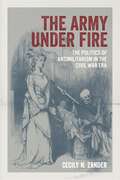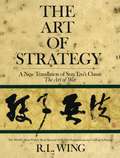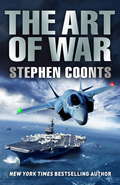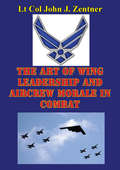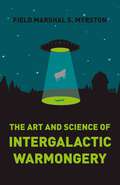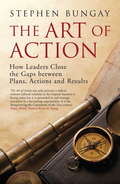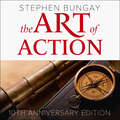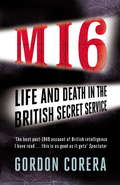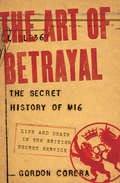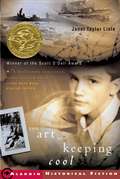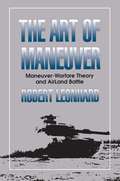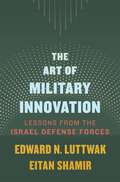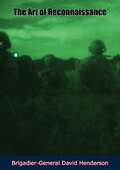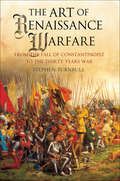- Table View
- List View
The Army under Fire: The Politics of Antimilitarism in the Civil War Era (Conflicting Worlds: New Dimensions of the American Civil War)
by Dr. Cecily N. ZanderCecily N. Zander’s The Army under Fire is a pathbreaking study focusing on the fierce political debates over the size and use of military forces in the United States during the Civil War era. It examines how prominent political figures interacted with the professional army and how those same leaders misunderstood the value of regular soldiers fighting to reunify the fractured nation.
The Arsenal of Democracy: FDR, Detroit, and an Epic Quest to Arm an America at War
by A. J. BaimeA New York Times BestsellerA dramatic, intimate narrative of how Ford Motor Company went from making automobiles to producing the airplanes that would mean the difference between winning and losing World War II. In 1941, as Hitler's threat loomed ever larger, President Roosevelt realized he needed weaponry to fight the Nazis--most important, airplanes--and he needed them fast. So he turned to Detroit and the auto industry for help.The Arsenal of Democracy tells the incredible story of how Detroit answered the call, centering on Henry Ford and his tortured son Edsel, who, when asked if they could deliver 50,000 airplanes, made an outrageous claim: Ford Motor Company would erect a plant that could yield a "bomber an hour." Critics scoffed: Ford didn't make planes; they made simple, affordable cars. But bucking his father's resistance, Edsel charged ahead. Ford would apply assembly-line production to the American military's largest, fastest, most destructive bomber; they would build a plant vast in size and ambition on a plot of farmland and call it Willow Run; they would bring in tens of thousands of workers from across the country, transforming Detroit, almost overnight, from Motor City to the "great arsenal of democracy." And eventually they would help the Allies win the war.Drawing on exhaustive research from the Ford Archives, the National Archives, and the FDR Library, A. J. Baime has crafted an enthralling, character-driven narrative of American innovation that has never been fully told, leaving readers with a vivid new portrait of America--and Detroit--during the war.
The Art Of Strategy
by R. L. WingMore than 2,500 years ago, Sun Tzu composed his masterpiece The Art of War which has been used by the world's greatest leaders including Napoleon. Here, Wing makes the influential philosophies of the Orient accessible to all seekers of professional achievement and personal excellence.
The Art Of War (Jake Grafton)
by Stephen CoontsIN THE LATEST BLOCKBUSTER FROM THE NEW YORK TIMES BESTSELLING AUTHOR, JAKE GRAFTON FACES A NIGHTMARE THREAT FROM A CHINESE SLEEPER CELL.While the US navy is distracted by hostile activity in the South China Sea, a nuclear weapon has been planted in the harbour of Norfolk, Virginia - the world's largest naval base. Jake Grafton, promoted to director of the CIA following the murder of his predecessor, is unaware of the insidious plot. Though he has received intelligence informing him that an attack is imminent.He does not know where. He does not know when. But he does know who to turn to in a time of crisis.Faced with the horror of a disaster that would eclipse Pearl Harbor in scale, Jake and his right-hand man Tommy Carmellini return in this explosive race-against time thriller.Loved The Art of War? Then read Flight of the Intruder, and join Jake Grafton and Tommy Carmellini from the very beginning . . .
The Art Of Wing Leadership And Aircrew Morale In Combat
by Lt Col John J. ZentnerLt Col John J. Zentner's The Art of Wing Leadership and Aircrew Morale in Combat addresses the role that the air force wing commander plays in affecting the level of aircrew morale during combat. More specifically, Colonel Zentner's study seeks to identify and define those unique characteristics associated with leading airmen that sustain aircrew morale in the face of significant losses.Colonel Zentner defines aircrew morale as the enthusiasm and persistence with which an aviator flies combat missions. He then offers three historical case studies to establish a framework within which aircrew morale can be assessed. The first case study is of Maj Adolf Galland and Jagdgeschwader 26 during the Battle of Britain. The second case study considers Lt Col Joseph Laughlin and the 362d Fighter Group during the invasion of France in the summer of 1944. The third case study examines Col James R. McCarthy and the 43d Strategic Wing during Operation Linebacker II. Drawing heavily on the results of questionnaires and personal interviews, each case study is focused on the importance that aircrews ascribed to three general areas: individual needs, group cohesion, and unit esprit de corps.Colonel Zentner concludes that aircrew control over development of combat tactics was the single most important element affecting morale. This finding supports one of the fundamental truths about the employment of airpower, centralized control and decentralized execution that has become embedded in the airman's culture. In each of the three cases studied by the author, morale generally improved when the wing commander either displayed a personal flair for tactical innovation or allowed his subordinates to become innovative. Conversely, morale declined when higher headquarters placed burdensome and unsound restrictions on aircrew tactics.
The Art Spy: The Extraordinary Untold Tale of WWII Resistance Hero Rose Valland
by Michelle YoungA riveting and stylish saga set in Paris during World War II, The Art Spy uncovers how an unlikely heroine infiltrated the Nazi leadership to save the world's most treasured masterpieces.On August 25, 1944, Rose Valland, a woman of quiet daring, found herself in a desperate position. From the windows of her beloved Jeu de Paume museum, where she had worked and ultimately spied, she could see the battle to liberate Paris thundering around her. The Jeu de Paume, co-opted by Nazi leadership, was now the Germans’ final line of defense. Would the museum curator be killed before she could tell the truth—a story that would mean nothing less than saving humanity’s cultural inheritance?Based on troves of previously undiscovered documents, The Art Spy chronicles the brave actions of the key Resistance spy in the heart of the Nazi’s art looting headquarters in the French capital. A veritable female Monuments Man, Valland has, until now, been written out of the annals, despite bearing witness to history’s largest art theft. While Hitler was amassing stolen art for his future Führermuseum, Valland, his undercover adversary, secretly worked to stop him.At every stage of World War II, Valland was front and center. She came face to face with Reichsmarschall Hermann Göring, passed crucial information to the Resistance network, put herself deliberately in harm’s way to protect the museum and her staff, and faced death during the last hours of Liberation Day.At the same time, a young Free French soldier, Alexandre Rosenberg , was fighting his way to Paris with the Allied forces battling to liberate France. Alexandre's father was the exclusive art dealer for Picasso, Matisse, George Braque, and Fernand Léger. The Nazis had taken everything from their family—their art collection, their nationality, their gallery, and their home in Paris. Vivid and atmospheric, The Art Spy moves from the glittering days of pre-War Paris, home to geniuses of modern culture, including Picasso, Josephine Baker, Coco Chanel, Le Corbusier, and Frida Kahlo, through the tension-riddled cities and resorts of Europe on the eve of war, to the harrowing years of the Nazi occupation of France when brave people such as Valland and Rosenberg risked everything to fight monstrous evil.In the spirit of Hidden Figures, with the sweeping narrative of The Rape of Europa and the depth of The Resistance Quartet, The Art Spy is an extraordinary tale of a female hero whose courage and tenacity in a time of violence and terror is an inspiration for us all.
The Art and Science of Intergalactic Warmongery
by Field Marshal MyrstonAs a young cadet, Private Myrston led troops against the Victoriana rebellion where he earned a reputation as a fearless soldier and cunning tactician. His meteoric rise to Emperor of the Molagrian Empire was paved with sound battle strategies, a winning smile and clever assassinations of several superior officers. As emperor, he sought out and engaged in countless conflicts with a multitude of sentient lifeforms during his reign. It was during this period that he mastered several forms of invasion, administration and religious manipulation for profit. In this text, Myrston has plagiarized wildly from Molagrian and Nebraxian classic texts infinitely better than this one to provide a concise set of tenants guaranteeing intergalactic success. Learn how to take control of the planet, establish a government that suits your needs and then seek out and annihilate exotic, intelligent lifeforms throughout the galaxy.
The Art of Action: How Leaders Close the Gaps between Plans, Actions and Results
by Stephen BungayWhat do you want me to do? This question is the enduring management issue, a perennial problem that Stephen Bungay shows has an old solution that is counter-intuitive and yet common sense. The Art of Action is a thought-provoking and fresh look at how managers can turn planning into execution, and execution into results. Drawing on his experience as a consultant, senior manager and a highly respected military historian, Stephen Bungay takes a close look at the nineteenth-century Prussian Army, which built its agility on the initiative of its highly empowered junior officers, to show business leaders how they can build more effective, productive organizations. Based on a theoretical framework which has been tested in practice over 150 years, Bungay shows how the approach known as 'mission command' has been applied in businesses as diverse as pharmaceuticals and F1 racing today. The Art of Action is scholarly but engaging, rigorous but pragmatic, and shows how common sense can sometimes be surprising.
The Art of Action: How Leaders Close the Gaps between Plans, Actions and Results
by Stephen BungayThe 10th Anniversary Edition of the Leadership ClassicThe surprisingly common sense approach to leading a global company, based on a theoretical framework first used by the nineteenth-century Prussian Army.For over a decade the approach known as 'mission command' has been taught at the leading HULT Ashridge International Business School and has been applied in transforming businesses as diverse as pharmaceuticals and F1 racing.What do you want me to do? This question is the enduring management issue, a perennial problem that Stephen Bungay shows has an old solution that is counter-intuitive and yet highly practical. The Art of Action is a thought-provoking and fresh look at how managers can turn planning into execution, and execution into results.Drawing on his experience as a consultant, senior manager and a highly respected military historian, Stephen Bungay takes a close look at the army which built its agility on the initiative of its highly empowered junior officers, to show business leaders how they can build more effective, productive organizations. (P) 2021 Hodder & Stoughton Limited
The Art of Being Governed: Everyday Politics in Late Imperial China
by Michael SzonyiAn innovative look at how families in Ming dynasty China negotiated military and political obligations to the stateHow did ordinary people in the Ming dynasty (1368–1644) deal with the demands of the state? In The Art of Being Governed, Michael Szonyi explores the myriad ways that families fulfilled their obligations to provide a soldier to the army. The complex strategies they developed to manage their responsibilities suggest a new interpretation of an important period in China’s history as well as a broader theory of politics.Using previously untapped sources, including lineage genealogies and internal family documents, Szonyi examines how soldiers and their families living on China’s southeast coast minimized the costs and maximized the benefits of meeting government demands for manpower. Families that had to provide a soldier for the army set up elaborate rules to ensure their obligation was fulfilled, and to provide incentives for the soldier not to desert his post. People in the system found ways to gain advantages for themselves and their families. For example, naval officers used the military’s protection to engage in the very piracy and smuggling they were supposed to suppress. Szonyi demonstrates through firsthand accounts how subjects of the Ming state operated in a space between defiance and compliance, and how paying attention to this middle ground can help us better understand not only Ming China but also other periods and places.Combining traditional scholarship with innovative fieldwork in the villages where descendants of Ming subjects still live, The Art of Being Governed illustrates the ways that arrangements between communities and the state hundreds of years ago have consequences and relevance for how we look at diverse cultures and societies, even today.
The Art of Betrayal: Life and Death in the British Secret Service
by Gordon CoreraThe secret history of MI6 - from the Cold War to the present day.The British Secret Service has been cloaked in secrecy and shrouded in myth since it was created a hundred years ago. Our understanding of what it is to be a spy has been largely defined by the fictional worlds of James Bond and John le Carre. THE ART OF BETRAYAL provides a unique and unprecedented insight into this secret world and the reality that lies behind the fiction. It tells the story of how the secret service has changed since the end of World War II and by focusing on the people and the relationships that lie at the heart of espionage, revealing the danger, the drama, the intrigue, the moral ambiguities and the occasional comedy that comes with working for British intelligence. From the defining period of the early Cold War through to the modern day, MI6 has undergone a dramatic transformation from a gung-ho, amateurish organisation to its modern, no less controversial, incarnation. Gordon Corera reveals the triumphs and disasters along the way.The grand dramas of the Cold War and after - the rise and fall of the Berlin Wall, the Cuban Missile Crisis, the 11 September 2001 attacks and the Iraq war - are the backdrop for the human stories of the individual spies whose stories form the centrepiece of the narrative. But some of the individuals featured here, in turn, helped shape the course of those events. Corera draws on the first-hand accounts of those who have spied, lied and in some cases nearly died in service of the state. They range from the spymasters to the agents they ran to their sworn enemies. Many of these accounts are based on exclusive interviews and access. From Afghanistan to the Congo, from Moscow to the back streets of London, these are the voices of those who have worked on the front line of Britain's secret wars. And the truth is often more remarkable than the fiction.
The Art of Betrayal: Life and Death in the British Secret Service
by Gordon CoreraThe secret history of MI6 - from the Cold War to the present day.The British Secret Service has been cloaked in secrecy and shrouded in myth since it was created a hundred years ago. Our understanding of what it is to be a spy has been largely defined by the fictional worlds of James Bond and John le Carre. THE ART OF BETRAYAL provides a unique and unprecedented insight into this secret world and the reality that lies behind the fiction. It tells the story of how the secret service has changed since the end of World War II and by focusing on the people and the relationships that lie at the heart of espionage, revealing the danger, the drama, the intrigue, the moral ambiguities and the occasional comedy that comes with working for British intelligence. From the defining period of the early Cold War through to the modern day, MI6 has undergone a dramatic transformation from a gung-ho, amateurish organisation to its modern, no less controversial, incarnation. Gordon Corera reveals the triumphs and disasters along the way.The grand dramas of the Cold War and after - the rise and fall of the Berlin Wall, the Cuban Missile Crisis, the 11 September 2001 attacks and the Iraq war - are the backdrop for the human stories of the individual spies whose stories form the centrepiece of the narrative. But some of the individuals featured here, in turn, helped shape the course of those events. Corera draws on the first-hand accounts of those who have spied, lied and in some cases nearly died in service of the state. They range from the spymasters to the agents they ran to their sworn enemies. Many of these accounts are based on exclusive interviews and access. From Afghanistan to the Congo, from Moscow to the back streets of London, these are the voices of those who have worked on the front line of Britain's secret wars. And the truth is often more remarkable than the fiction.
The Art of Betrayal: The Secret History of MI6: Life and Death in the British Secret Service
by Gordon CoreraFrom Berlin to the Congo, from Moscow to the back streets of London, these are the stories of the agents on the front lines of British intelligence. And the truth is often more remarkable than fiction.Gordon Corera provides a unique and unprecedented insight into this secret world and the reality that lies behind the fiction. He tells the story of how the secret service has changed since the end of the Second World War and, by focusing on the people and the relationships that lie at the heart of espionage, illustrates the danger, the drama, the intrigue, and the moral ambiguities that come with working for British intelligence. From the defining period of the early Cold War through modern day, MI6 has undergone a dramatic transformation from a gung-ho, amateurish organisation to its modern, no less controversial, incarnation. And some of the individuals featured here, in turn, helped shape the course of those events. Corera draws on the first-hand accounts of those who have spied, lied, and in some cases nearly died in service of the state. They range from the spymasters to the agents they controlled to their sworn enemies. And the truth is often more remarkable than the fiction.
The Art of Clear Thinking: A Stealth Fighter Pilot's Timeless Rules for Making Tough Decisions
by Hasard LeeTHE #2 WALL STREET JOURNAL BESTSELLERBased on a career of making high-stakes, split-second decisions as a U.S. fighter pilot, The Art of Clear Thinking teaches readers to apply Hasard Lee's combat-tested techniques in everyday life.The training to become a fighter pilot is among the most competitive and difficult in the world with fewer than one in a thousand succeeding. Pushing a cutting-edge jet to its limits at over 1,000 mph means that every split-second decision can have catastrophic consequences. This extreme environment has forged a group of warriors who for the last fifty years have been considered at the apex of decision-making theory and practice.In The Art of Clear Thinking, Hasard Lee distills what he’s learned during his career flying some of the Air Force’s most advanced aircraft. With gripping firsthand accounts from his time as a fighter pilot and fascinating turning points throughout history, Hasard reveals powerful decision-making principles that can be used in business and in life, including: • HOW TO LEARN BETTER AND FASTER• CULTIVATING MENTAL TOUGHNESS• DEVELOPING THE SKILLS TO QUICKLY ASSESS, CHOOSE, AND EXECUTE• AND MUCH, MUCH MOREHasard has used and taught these techniques across the full spectrum of human endeavors and proven their effectiveness in both the cockpit and the boardroom. Those who have already benefited include CEO’s, astronauts, CIA agents, students, parents, and many others. The Art of Clear Thinking is a book that will change how you interact with the world around you.
The Art of Darkness: Deception and Urban Operations
by Russell W. Glenn Dana J. Johnson Scott Gerwehr Ann FlanaganThis research was undertaken to gain a better understanding of the relationship between deception and the urban environment, first to explore the power of deception when employed against U.S. forces in urban operations, and second to evaluate the potential value of deception when used by U.S. forces in urban operations.
The Art of Intelligence: Lessons from a Life in the CIA's Clandestine Service
by Henry A. CrumptonA legendary CIA spy and counterterrorism expert tells the spellbinding story of his high-risk, action-packed career while illustrating the growing importance of America's intelligence officers and their secret missions. For a crucial period, Henry Crumpton led the CIA's global covert operations against America's terrorist enemies, including al Qaeda. In the days after 9/11, the CIA tasked Crumpton to organize and lead the Afghanistan campaign. With Crumpton's strategic initiative and bold leadership, from the battlefield to the Oval Office, U.S. and Afghan allies routed al Qaeda and the Taliban in less than ninety days after the Twin Towers fell. At the height of combat against the Taliban in late 2001, there were fewer than five hundred Americans on the ground in Afghanistan, a dynamic blend of CIA and Special Forces. The campaign changed the way America wages war. This book will change the way America views the CIA. The Art of Intelligence draws from the full arc of Crumpton's espionage and covert action exploits to explain what America's spies do and why their service is more valuable than ever. From his early years in Africa, where he recruited and ran sources, from loathsome criminals to heroic warriors; to his liaison assignment at the FBI, the CIA's Counterterrorism Center, the development of the UAV Predator program, and the Afghanistan war; to his later work running all CIA clandestine operations inside the United States, he employs enthralling storytelling to teach important lessons about national security, but also about duty, honor, and love of country. No book like The Art of Intelligence has ever been written--not with Crumpton's unique perspective, in a time when America faced such grave and uncertain risk. It is an epic, sure to be a classic in the annals of espionage and war.
The Art of Intelligence: Lessons from a Life in the CIA's Clandestine Service
by Henry A. CrumptonA legendary CIA spy and counterterrorism expert tells the spellbinding story of his high-risk, action-packed career while illustrating the growing importance of America's intelligence officers and their secret missions For a crucial period, Henry Crumpton led the CIA's global covert operations against America's terrorist enemies, including al Qaeda. In the days after 9/11, the CIA tasked Crumpton to organize and lead the Afghanistan campaign. With Crumpton's strategic initiative and bold leadership, from the battlefield to the Oval Office, U. S. and Afghan allies routed al Qaeda and the Taliban in less than ninety days after the Twin Towers fell. At the height of combat against the Taliban in late 2001, there were fewer than five hundred Americans on the ground in Afghanistan, a dynamic blend of CIA and Special Forces. The campaign changed the way America wages war. This book will change the way America views the CIA. The Art of Intelligence draws from the full arc of Crumpton's espionage and covert action exploits to explain what America's spies do and why their service is more valuable than ever. From his early years in Africa, where he recruited and ran sources, from loathsome criminals to heroic warriors; to his liaison assignment at the FBI, the CIA's Counterterrorism Center, the development of the UAV Predator program, and the Afghanistan war; to his later work running all CIA clandestine operations inside the United States, he employs enthralling storytelling to teach important lessons about national security, but also about duty, honor, and love of country. No book like The Art of Intelligence has ever been written-not with Crumpton's unique perspective, in a time when America faced such grave and uncertain risk. It is an epic, sure to be a classic in the annals of espionage and war.
The Art of Keeping Cool
by Janet Taylor LisleThe War At Home Fear permeates the Rhode Island coastal town where Robert, his mother, and sister are living out the war with his paternal grandparents: Fear of Nazi submarines offshore. Fear of Abel Hoffman, a German artist living outside of town.
The Art of Keeping Cool
by Janet Taylor Lisle<P>Fear permeates the Rhode Island coastal town where Robert, his mother, and sister are living out the war with his paternal grandparents: Fear of Nazi submarines offshore. Fear of Abel Hoffman, a German artist living reclusively outside of town. And for Robert, a more personal fear, of his hot-tempered, controlling grandfather. <P>As Robert watches the townspeople's hostility toward Hoffman build, he worries about his sensitive cousin Elliot's friendship with the artist. And he wonders more and more about the family secret everyone seems to be keeping from him -- a secret involving Robert's father, a bomber pilot in Europe. <P>Will Elliot's ability to detach himself from the turmoil around him be enough to sustain him when prejudice and suspicions erupt into violence? And can Robert find his own way to deal with the shocking truth about his family's past? <P><b> Winner of the Scott O'Dell Award for Historical Fiction </b>
The Art of Longsword Fighting: Teaching the Foundations of Sigmund Ringeck's Style
by Benjamin J. SmithThe teaching of Historical European Martial Arts has widespread appeal with numerous clubs in many countries. However, comparatively few people who run their own club have qualifications that would make them an instructor in traditional martial arts organizations. Even those with such qualifications lack in-depth cohesive resources for teaching a given style – often because they can only work from incomplete sources. Thus, the need for a book which is grounded in exhaustive research into historical teaching methods and in particular focusing on the specific style of Sigmund Ringeck, who was himself a teacher of fighting arts in the late 14th century or the early or mid-15th century. In The Art of Longsword Fighting, Benjamin J. Smith therefore offers the broader information necessary for teachers of historical swordsmanship to deliver courses based on original, authentic techniques. This includes the various cutting methods, the role of competition in learning these arts, the mechanics of the interpretive process, and insights into how to use a wide range of activities to enhance students’ experience. All of this is achieved through a panoply of photographs showing each move along with explanatory diagrams as well as detailing how and when to introduce each next step in a manner that is faithful to Ringeck’s style. There is no current literature available which demonstrates how each move should be undertaken and, most importantly, why each step should be taken in the sequences described. There is no doubt that a book of this nature has been long awaited and will be welcomed by instructors and students alike as well as those general readers interested in fencing and the longsword of the Renaissance period.
The Art of Maneuver: Maneuver-Warfare Theory and AirLand Battle
by Robert R. LeonhardLeonhard exposes as folly our view of war as an attritional phenomenon, measuring success in body counts and tons of explosives spent.
The Art of Military Deception
by Mark LloydThis in-depth analysis of military deception examines tactics employed across centuries and continents, from ancient times to WWII. The art of military deception is as old as warfare itself. It has been a vital part of virtually every successful campaign ever recorded, and yet has been largely overlooked in the annals of military history. In The Art of Military Deception, Mark Lloyd corrects this oversight with a wide-ranging analysis of strategies and tactics through the ages. Lloyd treats this much-neglected aspect of warfare thematically rather than chronologically covering such topics as disinformation campaigns, lies on the home front, and psychological warfare. He draws on a wide range of examples to show the elaborate techniques which have been employed in the struggle to outwit the enemy. Particularly fascinating is his analysis of the fatal error of self-deception.
The Art of Military Innovation: Lessons From The Israel Defense Forces
by Edward N. Luttwak Eitan ShamirA world-leading military strategist and an IDF insider explain the improbable success of the Israeli armed forces.When the Israel Defense Forces was established in May 1948, it was small, poorly equipped, and already at war. Lacking sufficient weaponry or the domestic industrial base to produce it, the newborn military was forced to make do with whatever it could get its hands on. That spirit of improvisation carried the IDF to a decisive victory in the First Arab-Israeli War.Today the same spirit has made the IDF the most powerful military in the Middle East and among the most capable in the world. In The Art of Military Innovation, Edward N. Luttwak and Eitan Shamir trace the roots of this astounding success. What sets the IDF apart, they argue, is its singular organizational structure. From its inception, it has been the world’s only one-service military, encompassing air, naval, and land forces in a single institutional body. This unique structure, coupled with a young officer corps, allows for initiative from below. The result is a nimble organization inclined toward change rather than beholden to tradition.The IDF has fostered some of the most significant advances in military technology of the past seventy years, from the first wartime use of drones to the famed Iron Dome missile defense system, and now the first laser weapon, Iron Beam. Less-heralded innovations in training, logistics, and human resources have been equally important. Sharing rich insights and compelling stories, Luttwak and Shamir reveal just what makes the IDF so agile and effective.
The Art of Reconnaissance
by Brigadier-General David HendersonSeminal work on the nature, principles and practice of the art of reconnaissance, which even despite the aircraft and satellites of today’s age remains an important task for military units worldwide. This edition includes Henderson’s chapter of aircraft reconnaissance which was only just being tested on the Western Front in 1914 when he published the second edition of this book.“THIS work is intended (and hence its pretentious title) to present a view of the subject of reconnaissance as a whole in the hope of assisting those whose duty or ambition it may be to prepare themselves to undertake the pursuit of information in war. There are two points which may seem to call for some explanation. If anyone should remark on the incompleteness of the work, and should complain that in discussing the details of reconnaissance. I have left a great deal unsaid, I would reply that I have endeavoured to consider only those details which seem to contain the germ of some principle of more or less general application. If, on the other hand, exception should be taken to the temerity of a foot-soldier in surveying; and perhaps overstepping the debatable ground which lies between the provinces of reconnaissance and cavalry tactics, my defence is that I went in search of knowledge and that such a quest is a reasonable excuse for trespass.”
The Art of Renaissance Warfare: From The Fall of Constantinople to the Thirty Years War
by Stephen TurnbullThe Art of Renaissance Warfare tells the story of the knight during the fifteenth and sixteenth centuries from the great victories of Edward III and the Black Prince to the fall of Richard III on Bosworth Field.During this period, new technology on the battlefield posed deadly challenges for the mounted warrior; but they also stimulated change, and the knight moved with the times. Having survived the longbow devastation at Crcy, Poitiers and Agincourt, he emerged triumphant, his armor lighter and more effective, and his military skills indispensable.This was the great age of the orders of chivalry and the freemasonry of arms that bound together comrades and adversaries in a tight international military caste. Men such as Bertrand du Guesclin and Sir John Chandos loom large in the pages of this book bold leaders and brave warriors, imbued with these traditions of chivalry and knighthood. How their heroic endeavors and the knightly code of conduct could be reconciled with the indiscriminate carnage of the 'chevauche' and the depredations of the 'free companies' is one of the principal themes of this informative and entertaining book.
